It’s been a year and a half since the shipping industry found itself in a new game without a play book. The COVID-19 pandemic made container, tanker, cruise ship and other companies as well as seafarers adjust to the new lockdown reality in a painful haste.
People doing their jobs at sea have shown particular courage and resilience staying on board for months, enduring quarantines and remaining at the constant risk of exposure to the coronavirus.
It seems that today the maritime industry has fully recovered, so it’s high time to check the list of the largest ships in the world 2021.
Contents
The Biggest Container Ship in the World
The World’s Largest LNG Powered Container Ship
The Largest Sailing Cargo Ship
The Biggest Cruise Ship in the World 2021
The Largest Vessel in the World Resumed Operations
The World’s Largest Bulk Carrier
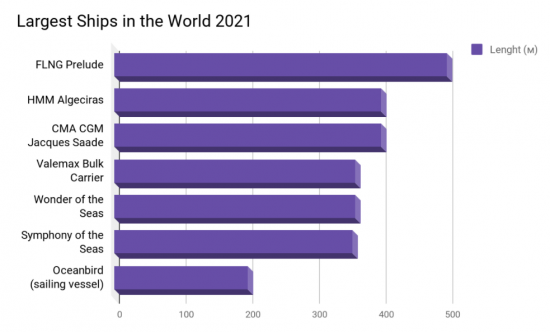
The Biggest Container Ship in the World
HMM Algeciras – 23 964 TEU
As of August 2021 the grand prix still belongs to HMM Algeciras – flagship of the South Korean shipping company HMM (formerly Hyundai Merchant Marine). Her capacity is 23 964 TEU (Twenty-foot equivalent) which surpasses the previous champion MSC Gulsun (2019) just for 208 containers.
Panama flagged HMM Algeciras was launched in April 2020. The ceremony at Daewoo Shipbuilding & Marine Engineering (DSME) shipyard was attended by Moon Jae-in, the president of South Korea.
The length of HMM Algeciras is 400 meters (1309 feet) which equals a standard Olympic stadium lap; the beam is 61 meters (200 feet) and the height is 33.2 meters (108.2 ft). The vessel works on a North Europe – Asia line.
HMM’s leadership looks more convincing from the 2021 year’s perspective as the flagship is now joined by eight sister ships named after famous maritime cities (HMM Oslo, HMM Copenhagen, etc.). In total, there will be 12 such behemoths carrying 24 000 TEUs each by 2022.
The World’s Largest LNG Powered Container Ship
CMA CGM Jacques Saade – 23 112 TEU
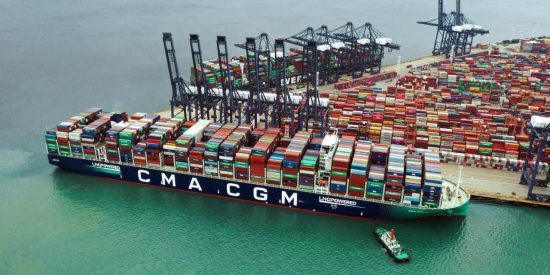
Although HMM Algeciras claims to be the most technologically advanced vessel, the true hi-tech champion arrived on September 22, 2020. CMA CGM Jacques Saade has become the biggest LNG fueled container ship in the world. It is 400 m (1 312 ft) long, 61.3 m (201 ft 1 in) wide and carries 23 112 TEUs, just 852 containers less than the world’s biggest container ship.
CMA CGM Jacques Saadé was the first from the fleet of 9 LNG-fueled super container ships. The flagship is named after the founder of CMA CGM company and her delivery was delayed by 10 months.
At present, all nine vessels have been transferred to CMA CGM; the latter, CMA CGM Concorde, was delivered just a month ago (7th July 2021). These vessels have become a true breakthrough in maritime technology. The capacity of the fuel tank is above 18 600 cubic metres (660,000 cu ft) of LNG which is enough to complete a vessel’s round trip between Asia and Northern Europe (23,372 nm or 43,285 km) without additional bunkering.
Naturally, LNG fuel presents some challenges as it must be stored at a temperature of −161 °C (−258 °F), but it helps to reduce sulfur dioxide emission by 99%, nitrogen oxide emissions by 92% and CO2 imprint is reduced by up to 20% compared with fuel-powered systems.
The Largest Sailing Cargo Ship
New generation LNG-fueled container ships are able to cut CO2 emission considerably, but what if that is not enough. According to IMO, the maritime industry accounts for 2.2% of global CO2 imprint. To put it in the context, if international shipping were the county it would be on the 6th place among the gravest carbon emitters ranking higher than the entire Germany.
Many companies go ‘back to the future’ seeking a solution. Sailing cargo ships are tested all over the world. The biggest concept today is Oceanbird constructed by Swedish Wallenius Marine.
The Oceanbird will be a car carrier able to transport 7 000 vehicles across the Atlantic in 12 days. Engineers promise an average speed of 10 knots.
The amazing vessel will be 200 m (656.2 ft) long and 40 m (131.2 ft) wide with 5 wing sails 80 meters high (262.5 ft) each. The total height of the vessel will be 105 meters above water, but it can be adjusted to 50 meters since wing sails are telescopic. Incidentally, the rigging is made of steel and composite materials and turns 360 degrees to harness the wind in an optimal way.
The Oceanbird will be equipped with an auxiliary engine to maneuver her from harbours, but CO2 inprint will be reduced up to 90%, nevertheless.
The delivery of the first big sailing cargo vessel is expected in mid 2024. The construction price will be higher compared to the ordinary RO-RO ship, but operational costs will be more modest. The creators claim that the same design can be applied as a cruise vessel, bulk carrier, tanker and so on.
The Biggest Cruise Ship in the World 2021
Speaking about cruise ships, there is still no change in the list of Top 10 Largest Cruise Ships in the World. The Royal Caribbean’s Symphony of the Seas holds her champion’s title.
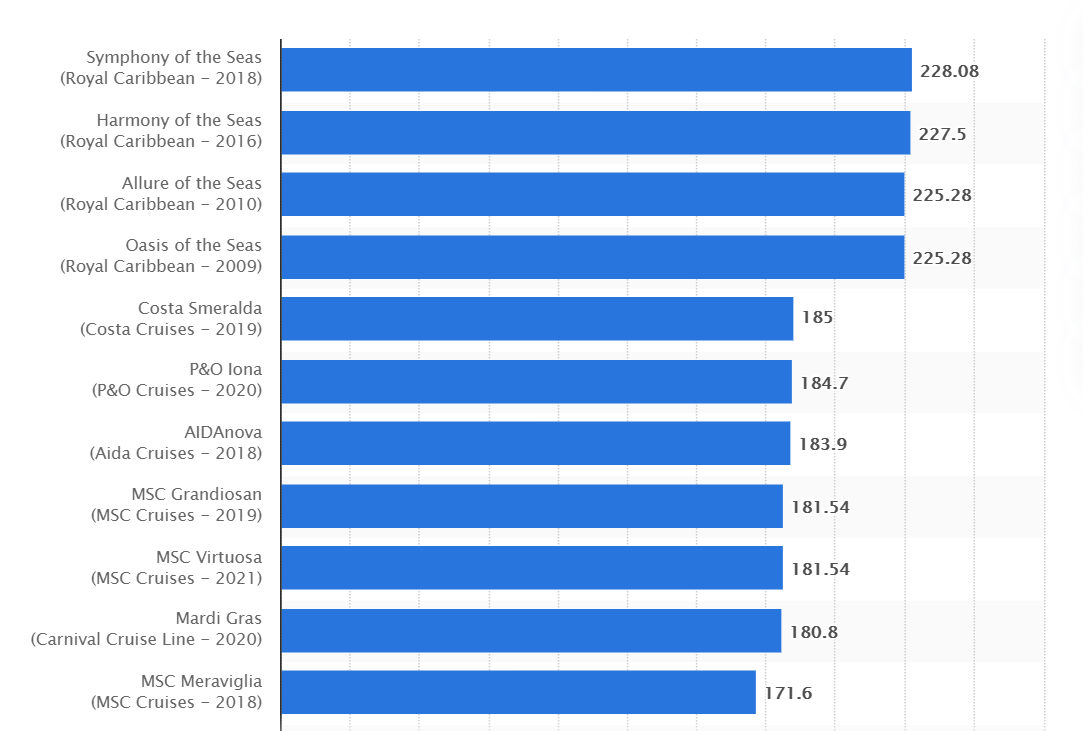
The Symphony was built in 2018 and measures 361 meters (1,184 ft) in length, 66 meters (217 ft) in beam, 72,5 m in height (238 ft) and her DWT is 18 095 tonnes. There are 18 decks accommodating 6 680 passengers at maximum capacity and 2200 crew members.
Today this giant cruise liner is doing 7 days round-trips around Western Caribbean (Miami – Mexico – Honduras – CocoCay, the Bahamas – Mexico again – Miami).
It is expected that she will remain in the Caribbean Sea for 2022 as well; adding Jamaica, St. Thomas, St. Kitts & Nevis and other destinations to her itinerary.
Meanwhile, in 2022 the title of the ‘biggest cruise ship’ will be intercepted by Wonder of the Seas. Royal Caribbean have opened sales for the inauguratory season of the new largest cruise ship in the world.
The company’s fifth Oasis-class ship is currently under construction in Saint-Nazaire (France), the delivery much delayed due to COVID-19 pandemic. She is 95% completed at the moment and will sail from Shanghai to Japan on 4 and 8 days trips starting from mid-March 2022.
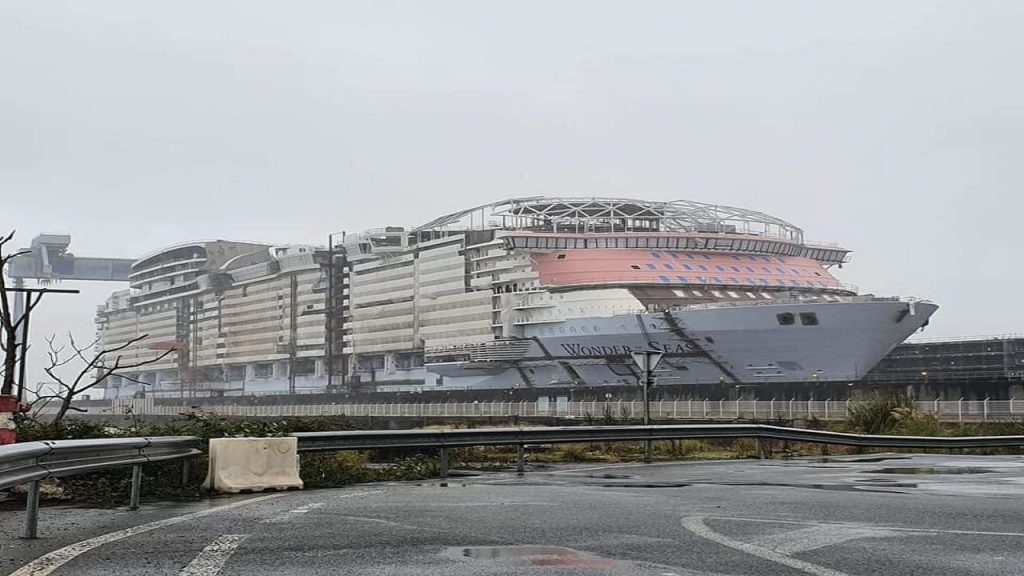
The Wonder of the Seas’s characteristics impress. For instanse, 51 Boeing – 777 jets might be needed to transport the same number of people:
Length – 362 m (1188 ft)
Beam – 64 m (154 ft)
Gross Tonnage – 236 857 t
Maximum Capacity – 6 988 guests
Cabins – 2 867
Crew – 2 300
Decks – 18
Engine – 4 x 7 500 hp
Speed – 22 knots
Starting from November 2022, The Wonder will head to Hong Kong for 4- and 9-night Christmas cruises with stops in Japan, Vietnam and South Korea.
The Wonder, as all Royal Caribbean vessels, promises some new experience compared to sister ships. There will eight ‘neighborhoods’:
1. The beloved Central Park which features 20 000 plants growing around cafes and restaurants.
2. Boardwalk – an open-air entertainment space at the aft with a classic hand-carved carousel, twin rock-climbing walls and the AquaTheater which will host famous acrobatic shows.
3. Pool & Sports Zone containing surf simulators (FlowRider), swimming pools and whirlpools. There is also a zip line stretching for 10 decks and the highest slide at sea – the Ultimate Abyss of the same height.
4. Entertainment Place will host all night-time shows, ice-skating rink and live karaoke space.
5. Royal Promenade – up-market boutiques and family entertainments.
6. Vitality Spa & Fitness Centre;
7. Youth Zone will provide all imaginable activities for children aged from 3 to 17 and nursery for infants and toddlers.
8. Suite Neighbourhood is Wonder’s specialty. It is reserved for suite guests only and offers private dining areas, sun deck and clubs. The Ultimate Family Suite is also situated there. This 1 134-square-foot cabin (105m2) sleeps 8, has a floor-to-ceiling LEGO wall and a whirlpool slide to speed up moving from the second level.
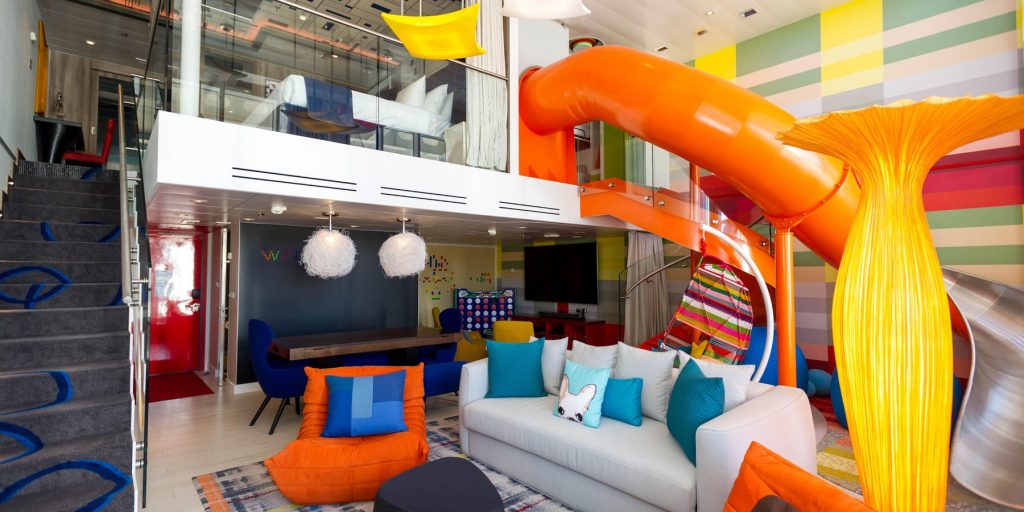
Judging from the reviews, though, the cabin is not particularly ‘parents-friendly’. It appears to be too noisy and offers no privacy as the master bedroom is effectively an open messonine.
The Largest Vessel in the World Resumed Operations
In case you’ve missed our piece on Offshore Giants, FLNG Prelude remains the biggest vessel in the world. This is an ingenious project by Shell that intended to develop a remote gas basin some 200 km off Australia coast. No pipeline can bridge this distance, so Shell has constructed a floating LNG plant which can be fixed over the basin and produce liquefied gas on the spot.
FLNG Prelude is 500 m long, 74m wide; capacity of her gas stores equals 175 Olympic size pools and she requires 840 engineers and crew members for day-to-day operation. It shipped its first gas in July 2019 (two years later than intended) and was forced to stop production in January 2020 due to safety issues in the liquefaction unit.
Officially, the problem was in an electrical trip, but Shell had faced a number of issues over the rest of 2020 trying to restart a full production. Operations were resumed in January 2021, but the proclaimed output of 3.6 million tonnes of LNG a year has not been reached so far.
“Prelude is a multi-decade project, and our focus is on delivering sustained performance over the long term,” Shell said in a statement, but the construction of FLNG required an unprecedented USD 17 bn.
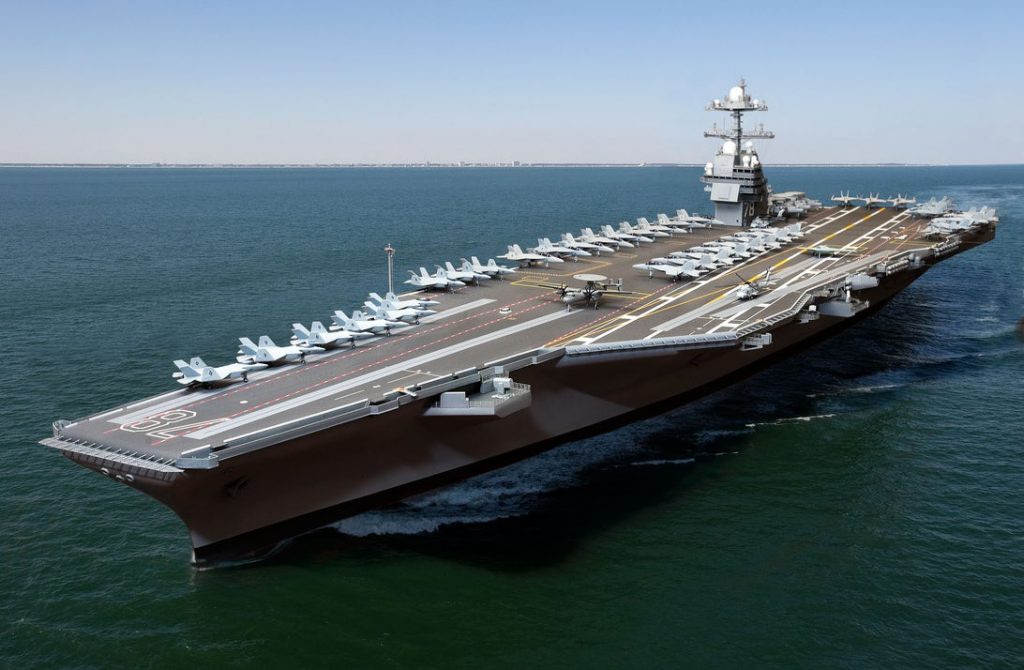
Prelude costs more than the latest US aircraft carrier USS Gerald R. Ford which has a $13 billion price tag. The company is bound to go a great length to return this money. We’ll keep you updated.
The World’s Largest Bulk Carrier
The 2nd-generation Valemax Bulkers remain the largest and most efficient bulk carriers in the world. The class derives its name from the Brazilian mining company Vale S.A; there were 68 such vessels in the world as of July 2020.
Valemax bulker (VLOC) details amaze:
Length – 362 m (1188 ft) that is 40 meters (131 ft) bigger than the Eiffel Tower;
Beam – 65 meters (213 ft) – the standard width of a soccer pitch.
Cargo capacity – 400 000 tons of iron ore;
Speed – 15 knots making a journey from Brazil to China (the largest importer in the world) in 45 days.

The timing is everything here as Brazil competes with Australia in the Asian market; and it takes 15 days only to cover the distance from the mines to Chinese ports for Australian vessels. Therefore, Valemax bulkers should offer some really convincing advantages:
- VLOC can transport more cargo per one trip;
- 16 000 tons of ore are loaded per hour;
- Valemaxes are designed to sail for 30 years;
- VLOCs have received Green Seal for releasing 35% less CO2 compared to standard Capesize Bulk Carrier.
There will be no record-breaking in the dry bulk sector in a short time perspective. The newbuilding orderbook is shockingly low at the moment (7.4% of the fleet); and experts agree that there might be even some shortage of vessels once the Covid-19 turmoil ceases and normal demand is restored in the market.

